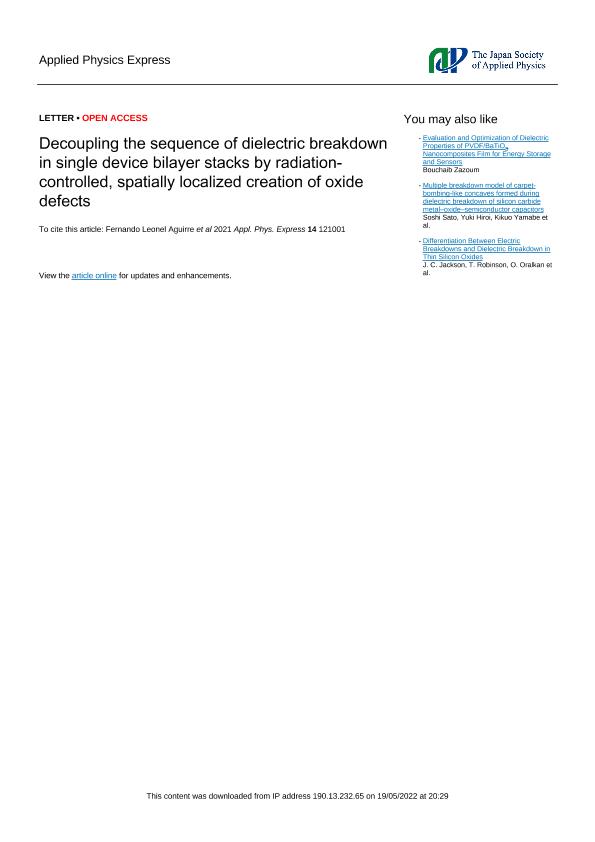Mostrar el registro sencillo del ítem
dc.contributor.author
Aguirre, Fernando Leonel

dc.contributor.author
Ranjan, Alok
dc.contributor.author
Raghavan, Nagarajan
dc.contributor.author
Padovani, Andrea
dc.contributor.author
Pazos, Sebastián Matías

dc.contributor.author
Vega, Nahuel Agustín

dc.contributor.author
Müller, Nahuel Agustín

dc.contributor.author
Debray, Mario Ernesto

dc.contributor.author
Molina Reyes, Joel
dc.contributor.author
Pey, Kin-Leong
dc.contributor.author
Palumbo, Félix Roberto Mario

dc.date.available
2022-05-19T20:00:34Z
dc.date.issued
2021-10
dc.identifier.citation
Aguirre, Fernando Leonel; Ranjan, Alok; Raghavan, Nagarajan; Padovani, Andrea; Pazos, Sebastián Matías; et al.; Decoupling the sequence of dielectric breakdown in single device bilayer stacks by radiation-controlled, spatially localized creation of oxide defects; Japan Society Applied Physics; Applied Physics Express; 14; 12; 10-2021; 1-5
dc.identifier.issn
1882-0778
dc.identifier.uri
http://hdl.handle.net/11336/157851
dc.description.abstract
The breakdown (BD) sequence in high-K/interfacial layer (HK/IL) stacks for time-dependent dielectric breakdown (TDDB) has remained controversial for sub-45 nm CMOS nodes, as many attempts to decode it were not based on proper experimental methods. Know-how of this sequence is critical to the future design for reliability of FinFETs and nanosheet transistors. We present here the use of radiation fluence as a tool to precisely tune the defect density in the dielectric layer, which jointly with the statistical study of the soft, progressive and hard BD, allow us to infer the BD sequence using a single HfO2–SiOx bilayered MOS structure.
dc.format
application/pdf
dc.language.iso
eng
dc.publisher
Japan Society Applied Physics

dc.rights
info:eu-repo/semantics/openAccess
dc.rights.uri
https://creativecommons.org/licenses/by/2.5/ar/
dc.subject
BREAKDOWN
dc.subject
SPATIAL CORRELATION
dc.subject
HIGH-K
dc.subject.classification
Nano-materiales

dc.subject.classification
Nanotecnología

dc.subject.classification
INGENIERÍAS Y TECNOLOGÍAS

dc.title
Decoupling the sequence of dielectric breakdown in single device bilayer stacks by radiation-controlled, spatially localized creation of oxide defects
dc.type
info:eu-repo/semantics/article
dc.type
info:ar-repo/semantics/artículo
dc.type
info:eu-repo/semantics/publishedVersion
dc.date.updated
2022-05-10T14:24:19Z
dc.journal.volume
14
dc.journal.number
12
dc.journal.pagination
1-5
dc.journal.pais
Japón

dc.journal.ciudad
Tokyo
dc.description.fil
Fil: Aguirre, Fernando Leonel. Consejo Nacional de Investigaciones Científicas y Técnicas; Argentina. Universidad Tecnológica Nacional. Facultad Regional Buenos Aires. Unidad de Investigación y Desarrollo de las Ingenierías; Argentina
dc.description.fil
Fil: Ranjan, Alok. Singapore University of Technology and Design ; Singapur
dc.description.fil
Fil: Raghavan, Nagarajan. Singapore University of Technology and Design ; Singapur
dc.description.fil
Fil: Padovani, Andrea. Applied Materials—MDLx; Italia
dc.description.fil
Fil: Pazos, Sebastián Matías. Consejo Nacional de Investigaciones Científicas y Técnicas; Argentina. Universidad Tecnológica Nacional. Facultad Regional Buenos Aires. Unidad de Investigación y Desarrollo de las Ingenierías; Argentina
dc.description.fil
Fil: Vega, Nahuel Agustín. Consejo Nacional de Investigaciones Científicas y Técnicas; Argentina. Comisión Nacional de Energía Atómica; Argentina
dc.description.fil
Fil: Müller, Nahuel Agustín. Comisión Nacional de Energía Atómica; Argentina
dc.description.fil
Fil: Debray, Mario Ernesto. Comisión Nacional de Energía Atómica; Argentina
dc.description.fil
Fil: Molina Reyes, Joel. Instituto Nacional de Astrofísica, Óptica y Electrónica; México
dc.description.fil
Fil: Pey, Kin-Leong. Singapore University of Technology and Design; Singapur
dc.description.fil
Fil: Palumbo, Félix Roberto Mario. Consejo Nacional de Investigaciones Científicas y Técnicas; Argentina. Universidad Tecnológica Nacional. Facultad Regional Buenos Aires. Unidad de Investigación y Desarrollo de las Ingenierías; Argentina
dc.journal.title
Applied Physics Express

dc.relation.alternativeid
info:eu-repo/semantics/altIdentifier/url/https://iopscience.iop.org/article/10.35848/1882-0786/ac345d
dc.relation.alternativeid
info:eu-repo/semantics/altIdentifier/doi/http://dx.doi.org/10.35848/1882-0786/ac345d
Archivos asociados
